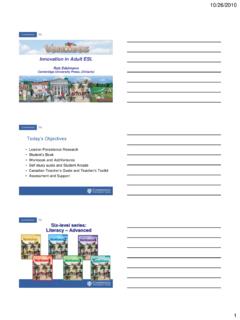Transcription of Best Practices for New Product Development - Stanski
1 Best Practices for New Product Development Page 1 of 4 Best Practices for New Product Development A White Paper for Innovative Organisations Stanski Consulting & Ventures 1. Introduction The purpose of this white paper is to highlight the risks, opportunities and best Practices that are associated with new Product Development activities. In doing so, it is anticipated that Stanski Consulting will guide Ventures customers to gain an initial awareness into the necessary Product Development activities associated with a successful new Product delivery through to ultimate Product launch.
2 2. New Product Development Areas of Work There are approximately 28 high levels of contributing factors that are involved in New Product Development (NPD). In studying past successful NPD projects, only by focusing on all these factors simultaneously can a successful delivery of a new Product be achieved. Thus it is insufficient to purely focus on only some aspects of the following NPD areas of work and expect a successful delivery, launch and commercial success for a new Product . The following factors are listed below and do not have a priority assigned to them due to equal importance in the NPD life cycle.
3 Business and Product Strategy Product and Pipeline Management Technology Management Management and Leadership Early Involvement Product Development Teams Organizational Environment Process Management Process Improvement Understanding the Customer Requirements and Specifications Management Development Process Integration Supplier/Subcontractor Integration Configuration Management Design Assurance Project & Resource Management Design for Manufacturability/Delivery Product Cost Management Robust Design Integrated Test Design and Program Design for Operation and Support Product Data Design Automation Simulation and Analysis Support Technology Knowledge Management Product Launch Ongoing Operations Ongoing Product Innovation 3.
4 New Products Categories There are many different types of new products. Their Newness can be defined as two types: 1. New to the company, in the sense that the business has never made or sold this type of Product before, but other firms might have; Best Practices for New Product Development Page 2 of 4 2. New to the market or innovative the Product is the first of its kind on the market. These two types of newness can be further broken down into six classes of products and their frequency in the market place: New to the World Products First of their kind and create an entirely new market.
5 These NPD lines make up approximately 10% of new products. New Product Lines Not new on the market but new to the business. They allow the business to enter a completely new market segment. These NPD lines make up approximately 20% of all new products. Additions to existing Product Lines These are new items to the business, but they fit within an existing Product line that the business already produces. They may represent a fairly new Product to the market. These NPD lines make up approximately 26% of new products. Improvements and Revisions to Existing Products These not so new products are replacements of existing Product lines.
6 These new and improved Product lines are incremental innovations and make up approximately 26% of new products. Repositioning These are new applications for existing products. They involve the retargeting of an old Product to a new market segment. These improvement Product lines make up approximately 7% of new Product developments. Cost Reductions These are the least new of all new Product categories. Essentially these NPD lines are designed to replace existing Product lines while providing similar benefits and performance but at significantly lower costs to the business. These Product innovations make up approximately 11% of new products.
7 5 NPD Successes & Risks By assessing new Product Development activities into the above mentioned classes, projects can be classified into high or low risk success categories. The percentage breakdowns listed above represent the likelihood of successful NPD line in the market place. These numbers represent successful products lines that were completed and successfully launched by the organisation. According to industry research [1], on average, new Product lines (less than 5 years old) currently account for a staggering 33% of company sales. While these numbers are encouraging and do promote the need for new Product Development efforts within growth hungry organisations, it is important to realise that the survival rate of new products is also very low.
8 According to further research [1, 2], for every 7 developed concepts/ideas, only 1 becomes successful, and for every 4 Development projects trying to create the envisioned concept, only 1 becomes a commercial success. While the rewards associated with successful Product lines are great the chances of betting on a commercial winner are slim. 6 Best Practices for NPD Projects Since there are so many contributing factors that lead to a potentially successfully Best Practices for New Product Development Page 3 of 4 Product , studies [2, 3] have identified that there are only two fundamental ways at winning at the new Product innovation game.
9 These are primarily achieved by doing projects right and engaging by doing the right projects . Doing Projects Right The common denominators of successful new Product Development projects include: doing the planning homework up front prior to commencement of Product Development getting an early, sharp and stable Product definition building in the voice of the customer into the Product (an actual tested and validated customer need) employing true cross functional teams facing up to mandatory project costs (invest in the necessary infrastructure) avoid unnecessary project haste by understanding the likely schedules and eliminate the Load, Fire, then Aim mentality resulting from cutting corners.
10 Doing the Right Projects Equally important but often missed is the issue of doing the right projects. Project selection for Go, Halt and Kill decision points becomes very important to the overall success of new products. Since there are usually windows of opportunity during which a Product may become successfully in the market, such external factors must also be considered during project decision points. Empowering the Product Manager The act of project selection and Go/Halt/Kill decisions should exclusively be handled by the portfolio management team. Within portfolio management, the assigned Product manager (PM) is responsible for their respective project.





